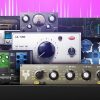-
 play_arrow
play_arrow
Clubalicious Clubalicious Radio
-
 play_arrow
play_arrow
London Calling Podcast Yana Bolder

So many new pro audio and music products are released each year that it becomes difficult to make fair comparisons or put together a “Best Of” or “Top 25” list. How do you choose when presented with a new $10,000 single-channel analog compressor and a $79 distortion plug-in? In that spirit, please consider this our annual “Gear of the Year” list, where there’s something for every type of audio pro.
To put together the 2024 Gear of the Year selection, we asked longtime Mix contributors and product reviewers Steve La Cerra, Mike Levine, Rich Tozzoli, Barry Rudolph and Michael Cooper to send in a few of their favorites. Here, presented in alphabetical order, are those selections:
AVID PRO TOOLS 2024.10

As a longtime user of Avid’s Pro Tools platform, I appreciate that the company is constantly improving its functionality and flow. At the recent AES show in NYC, I saw enough useful features in 2024.10 that I had to go home and update as soon as I could. And, wow! I’m glad I did.
As a composer, I value the integration of Kontakt 8 into this release. Many of my virtual instruments and orchestral libraries lie within the Kontakt environment, so this is good news. Avid partnered with Native Instruments to include Kontakt 8 Player and a Factory Essentials instrument library; the new Leap is an innovative way to manipulate samples. Input monitoring is now available on Instrument tracks, and there are a bunch of useful Session Data Import enhancements.
ARA2 support for Steinberg’s SpectraLayers and Wavelab is included, and SpectraLayers Go and Wavelab Go are included. SpectraLayers bring the ability to “pull apart” final mixes, such as taking the vocal layer out of a track. Wavelab Go is a useful tool for analyzing and conforming in real time to loudness specs—great for music and/or post.
There are a few Dolby Atmos updates, including the ability to solo individual speakers (or a group of them) in the Renderer. Also included is the ability to create MIDI playlists and MIDI effect plug-ins from 510k and BLEASS. 510k Lite is a cool polyrhythm-enabled MIDI sequencer, and BLEASS arpeggiator allows for a number of super-configurable and creative arpeggios. —Richard Tozzoli
BETTERMAKER VALVE STEREO PASSIVE EQUALIZER

Bettermaker’s Valve Stereo Passive Equalizer is the tube version of the company’s transistor model, the Stereo Passive Equalizer. The VSPE uses two miniature triode tubes for the makeup amplifiers in lieu of the transistorized output stages of the SPE. The basic operation is the same for both units, and the front panel’s control layout is identical.
Both the VSPE and SPE are stereo, two-band, passive equalizers with selectable frequency and variable bandwidth, modeled on the famed Pultec EQP-1A. EQ changes are synchronous and can be made on either the VSPE’s front panel or remotely as a (AU, VST, or AAX) plug-in in your DAW.
The VSPE connects to your computer using a USB cable, though no audio passes through. The plug-in includes an onboard, digital semi-parametric high-pass and low-pass filter. I thought this filter sounded
great, and setting it became my first workflow step when developing an EQ setting.
Mousing a control knob, flipping a switch, or clicking on a node in the plug-in’s spectrum analyzer window are all indicated on the VSPE’s front panel, displayed via a ring of red LEDs surrounding each rotary encoder knob. Similarly, changes made back on the VSPE’s front-panel controls are reflected in the plug-in’s GUI. —Barry Rudolph
EVENTIDE H3000 FACTORY MK II

There’s a reason this Eventide plug-in is a classic, but now it’s in MK II form for even more modulation madness. Besides the cool, updated look from the MK I, you can also now resize it. More importantly, the team went into the original hardware and took extensive audio measurements, including modeling of the converters—something that’s not in the original release.
I highly recommend jumping into the 500-plus presets once you’re set up, as this plug can do so many things that it’s best not to get overwhelmed right away. The useful menu dropdown features such subsets as H3000 Legacy, Delay, Pitch Shifting, Filtering & Wah, Modulation, Building Blocks, Sound Design, etc. From there, you can jump into different sounds from each category and audition them.
Right out of the gate, I found a few go-to’s for certain types of tracks. On guitars, when I want to go wide and big (I usually track most parts in stereo, so this would be on a stereo group fader), it would be Micropitch Slap in the H3000 Legacy menu. It features a 9% pitch up L and 9% pitch down R, with some Slap delay. To tighten up the delay, click the Session tempo to lock to your DAW, then press the soft key under Slap. By turning the large function knob, you can dial in the amount to your choice (usually under 10% for just the right touch). Pushing the output up a few dB, you’re left with a big and bold sound that spreads the guitars out and makes them richer.
The same setting is magic on background vocals, but you can also try using a simple flanger block (under Building Blocks), then drag and drop any of the modules to go even deeper. Going into the Expert tab, you can see and change any of the parameters associated with that patch. It may look a little complex, but it’s actually quite easy and offers a lot of flexibility. —Richard Tozzoli
IZOTOPE RX 11 ADVANCED

A new mid-side processing option lets you selectively quell excess noise and room tone in stereo recordings’ hard-panned instruments, sending hissing electric guitar amps to A Quiet Place. In iZotope RX 11 Advanced’s Dialogue Isolate module (and its twin plug-in), wideband processing is so yesterday; now you can independently reduce noise and/or reverb in four user-delimited frequency bands, all while preserving the fundamental track’s spectral balance with remarkable fidelity. You can thank AI for that—many of RX 11’s processors have been turbocharged with a new and improved neural net that, in my real-world experience, delivers results often approaching miracles.
The Music Rebalance module and plug-in are prime examples showcasing iZotope’s AI magic. If you’ve ever tried to split two elements of a mix having almost entirely overlapping frequencies and similar dynamics into separate stems, you know that’s a particularly knotty problem beyond ordinary remixing software’s capabilities. RX 11 Advanced makes the operation child’s play, with new Sensitivity knobs letting you control to which stem the quietest bits are sequestered.
RX 11 Advanced also gives you an edge in making your music stand out on streaming platforms, and not just by letting you audition different types of lossy encoding before surrendering your masters to online processing (RX 11’s added Streaming Preview module affords that). The new Loudness Optimize module tricks a platform’s loudness normalization process into streaming your track at a louder level—while leaving peak levels unchanged. It’s just another example of why iZotope RX 11 Advanced is a gotta-have-it software bonanza for anyone working in post-production, restoration or mastering. —Michael Cooper
JH AUDIO PEARL + RUBY IEMS SYSTEM

The JH Audio Pearl + Ruby IEM system from JH Audio is unique, consisting of Ruby earpieces and the companion Pearl Processor, a triamp belt pack constructed by Pearl to JH Audio specs. Ruby earpieces have an internal, passive low-pass filter, while all other crossover functions are handled via DSP built into the Pearl Processor.
Ruby earpieces are available as generic or custom-fit, both supplied with a headphone cable terminated with a locking, 10-pin ODU connector that mates with the Processor. As a result, they cannot be used with conventional 3.5mm audio outputs, nor can the Processor be used with other IEMs. The Pearl Processor is described by JH Audio as a “micro speaker management system designed for IEMs,” employing DSP at 96 kHz and an actively controlled passive crossover that reduces latency to levels between .60 and .80 milliseconds.
JH Audio Pearl + Ruby IEMs — A Mix Real-World Review
The Processor is controlled using three applications that run under Windows: Pearl GUI, Pearl Loader and Pearl Updater. GUI enables a user to control gain, phase, time alignment, equalization of low, mid, and high frequencies, and levels for low, mid and high-frequency drivers of the Ruby earpieces. Independent adjustments for the left and right earpieces allow compensation at the component level for differences in hearing between a listener’s left and right ears with far more precision and repeatability than simply applying EQ to the bus output from a mixing console.
One of the most significant capabilities of the Pearl + Ruby system is that, given an audiogram for a particular performer’s hearing, the response of the Ruby earpieces can be modified to allow a monitor engineer to mimic what a performer is hearing in their IEM mix. It’s then possible to create presets for each performer that reconcile the differences in hearing between the monitor engineer and the respective performers—which is a total game changer. —Steve La Cerra
COME BACK TOMORROW FOR PART 2!
Written by: Admin
Similar posts
Recent Comments
No comments to show.Featured post

Latest posts
Current show
Upcoming shows

Made To Move
Jacob Colon
19:00 - 20:00
In Session
Sister Bliss
20:00 - 21:00
Fresh Is Fresh
This Weeks Hottest Releases
21:00 - 00:00
Uplifting Only
Ori Uplift
00:00 - 02:00
Fresh Is Fresh
This Weeks Hottest Releases
02:00 - 09:00Chart
Powered by Dee jay promotions visit us













 Invalid license, for more info click here
Invalid license, for more info click here